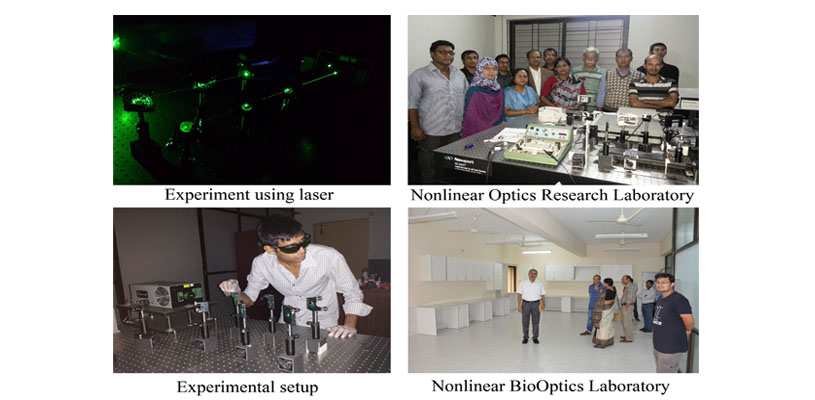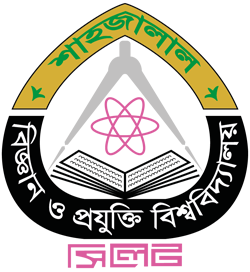Shahjalal University of Science and Technology
-
Overview
-
Academic
- Program
- Admission
- Curriculum
- Student Engagement & Support
-
Research
-
Faculty
-
Student Adviser
-
Former Head
-
Officers
-
Scholarship
-
Activities
-
Announcement
- Notice Board
- News & Events
-
Awards & Honours
- Graduate Student Awards
- Research Awards
- Teaching Awards
- Service Awards
-
Alumni
-
Collaboration
- Academic
- Research
- Student Chapter
-
Contact Us
Research

The Physics department considers direct experience with ongoing research. It is a good way to find out what working in Physics is actually like, and whether it's something you really want to do or not. It's an entirely different experience than classes. Most research groups in the department are run by a single professor and may involve several graduate students, and in many cases some undergraduates. Some are larger and have several professors collaborating on a single project. Research on Laser and Non-linear Optics, Biophysics, Nuclear Physics, Biophysics, Reactor Physics, Cosmology, Astrophysics, Atmospheric Physics, Theoretical non-linear Optics, Relativistic Quantum Information, Radioactive Waste Disposal, Nanostructure Physics, Organic Optoelectronics and Solid State Physic is in progress. Existing research laboratories are:
A. Computational Laboratory:
The Computational Laboratory in the Department of Physics was established in 2007. The aim of this laboratory is to develop and enhance sufficient skills of the students of this department for advanced scientific simulation physics. The researchers have released and maintaining a Scientific Light-weight Linux Operating System (TeLiSc OS). Parallel computing is ongoing with a newly configured cluster computer in the field of Nonlinear Optics and Material Science.
B. Nonlinear Optics Research Laboratory:
Theoretical courses in Nonlinear Optics were started in the department nearly twenty years ago. Experimental work was first started with the help of a small Science Ministry grant in 1999. Now a very sophisticated state of the art modern Nonlinear Optics Research Laboratory has been set up in the Department of Physics with the help of the HEQEP grant.
Ph.D, M. Phil and Masters students are actively involved in various experimental works, leading to publications in National and International journals.
C. Condensed Matter Physics Laboratory:
Samples are prepared in this lab to investigate phase transitions at different temperature using room and low temperature x-ray diffraction, SEM that confirms the Crystal Structure. Condensed Matter Physics group has collaboration with Bangladesh Council for Scientific and Industrial research (BCSIR), Dhaka and Kanazawa University, Japan.
D. Nanostructure Physics Computational Laboratory:
Nanostructure Physics of Quantum Well of Symmetric Double Barrier and Single Rectangular Tunnel Barrier are investigated in this laboratory. Electronic Structure of nanostructures are calculated.
E. Nonlinear BioOptics Research Laboratory:
The experimental research work done in the Nonlinear Research Laboratory led the researchers to look into the possible potential applications of their interesting results. In 2015 a proposal was submitted and in 2016 a second HEQEP project (University-Industry Research Collaboration) was awarded to the Department of Physics under which a very modern Nonlinear BioOptics Laboratory has been set up. This laboratory will enable the researchers to investigate the nonlinear optical parameters of bio-molecules, organic and inorganic liquids. Interesting experimental outcomes are already being reported by the current research team.
F. Clean Room for Organic Optoelectronic Research:
This clean Room is established this year with the Research Award obtained from The World Academy of Sciences (TWAS) and SUST Research Center. Thin solid films and solution samples for are prepared here for Organic Optoelectronics Research. A clean room environment for scientific research is obtained with a controlled level of contamination such as dust, airborne, aerosol particles, and chemical vapors. Collaboration with colleagues of this, in other universities and researchers from abroad has been established to run research work in Organic Optoelectronics.
Details of Nonlinear Optics Research
(i) Start of Research
The field of Nonlinear Optics started after the invention of lasers in 1961. It involves the study of intense laser light with materials. The presence of intense light in a medium results in optical modification of its properties leading to interesting phenomena and related applications. It was in 1996 that plans were first made to start research in this field in the Department of Physics at SUST. It was envisioned that expenses involved in setting up a Nonlinear Optics Laboratory would be feasible and not impossible in a public university.
(ii) Theoretical
To build up the theoretical background of the students interested in this field, courses were designed with an up to date syllabus. Books on Nonlinear Optics were made available for the students and theoretical courses were offered, at the undergraduate level, from 1997 in the Department of Physics at SUST. Advanced graduate level courses in Nonlinear and Photorefractive Optics, along with a course on Lasers, were soon added to the curriculum to enhance the understanding and theoretical foundation of the students interested in research in this area.
(iii) Experimental
A small grant was given by the Science Ministry of Bangladesh, in 1999, to start the experimental work. An Ar-Ion laser was procured and a home made optical table constructed to do the initial simple optical measurements. In the meantime, a search for funding for an optics laboratory had been initiated. It seemed like a golden opportunity when the University Grants Commission (UGC) announced in 2010 that proposals could be submitted for grants under the Higher Education Enhancement Program (HEQEP).
. Proposals were submitted from the Department of Physics for Academic Innovation Fund subprojects of HEQEP given from the Ministry of Education with the financial and technical support of the World Bank.
HEQEP Projects
(i) In the first call of the AIF subproject launched in May 2010 by the UGC, under Window 2, a research proposal was submitted for the study of the fundamental properties of nonlinear optical materials titled: “Optical Properties and Structure Analysis of Nonlinear Materials.”
The award of this subproject made a significant difference and made it possible to set up a very highly sophisticated, state of the art, nonlinear optics laboratory in the Department of Physics at SUST.
(ii) The UGC solicited proposals on University-Industry Research Collaboration under Windows 4 –Innovation Fund in September 2015. This was an attempt to build a strong and diverse academia-industry relationship. The NLO group submitted a proposal, emphasizing the applications side of the research and the knowledge acquired from experimentation in the already established Nonlinear Optics Research Laboratory. This proposal titled: “Innovative Biomarker Detection System Using Nonlinear Optics” led to the award of the 2nd HEQEP project to the Department of Physics, as the entity of the project.
Nonlinear Optics (NLO) Research Group:
Group Leader: Prof. Yasmeen Haque
Faculty: Prof. Dr Syed Badiuzzaman Faruque, Prof. Susanta Kumar Das, Prof. Sharif. Md. Sharafuddin, Anock Somadder, Md. Enamul Hoque, Ponkog Kumar Das
Researcher (PhD, M. Phil, M S): Manash Kanti Biswas, Mohammed Rumman Ahmed, Kallol Chakrabarty, Md Moiuddin Tasnim, Robi Kormokar, Mohamaya Deb, Ruma Das, Md. Rezaur Rahaman
Associate Members (Student): A. K. M. Maruf Hossain, Sharmin Akter, Susmita Bhattacharjee
Laboratory Facilities
(i) Nd:Yag Laser
(ii) Ar-Ion Laser
(iii) He-Ne and DPSS Lasers
(iv) Electronics Laboratory
(v) Workshop
(vi) Optical Table and Optical Components
(vii) Digital Oscilloscope
Rules to be maintained by all members
Access to this research facility is available for all, subject to the rules below:
(i) Having research association with the laboratory
(ii) Non Disclosure Agreement (NDA) signed
(iii) Multidisciplinary personnel associated with the project research activities
